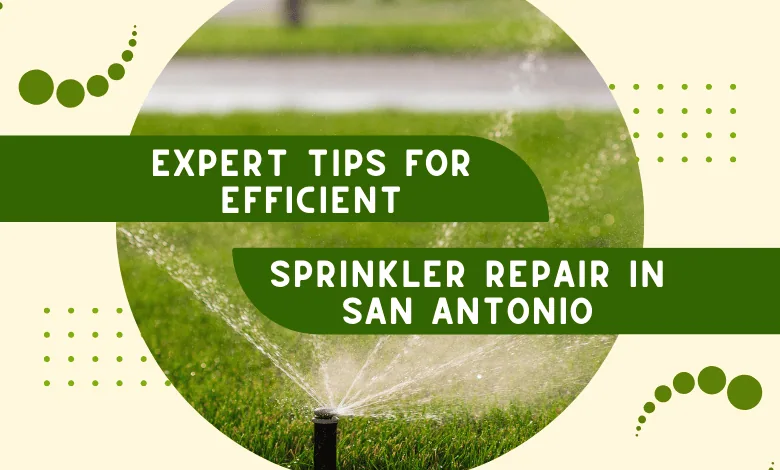Expert Tips for Efficient Sprinkler Repair in San Antonio

Understanding common sprinkler issues is essential for maintaining a healthy landscape. From malfunctioning timers to broken sprinkler heads and uneven water distribution, these problems can lead to overwatering, dry patches, and inefficient irrigation. By identifying and addressing these issues, homeowners can ensure their sprinkler systems run smoothly, avoid costly repairs, and keep their lawns thriving year-round.
Understanding Common Sprinkler Issues: What’s Really Going Wrong?
Malfunctioning Timers: A Deep Dive into Timing Troubles
Sprinkler timers are the brains of the irrigation system, controlling when your sprinklers run and for how long. Malfunctioning timers can lead to overwatering or underwatering, both of which can wreak havoc on your landscape. Various problems can occur with timers, including electrical failures, incorrect settings, and issues with the manual override function. If the timer is not receiving power, it may not operate at all. Check if it’s plugged in properly or if there may be any blown fuses or tripped circuit breakers at play. Sometimes, a simple reset can do the trick, but if the issue persists, you might find yourself needing a replacement. Furthermore, improper programming can lead to watering at undesirable times; therefore, ensure that the programming is in accordance with seasonal changes to optimize water usage and adhere to local watering restrictions, especially prevalent in drought-prone areas like San Antonio.
Broken Sprinkler Heads: Identifying and Fixing the Signs
Broken sprinkler heads can cause dry patches or waterlogged areas in your lawn. Common signs include leaks, water bubbling from the ground, or missing heads. These issues often result from physical damage, wear and tear, or landscaping work. Identifying your sprinkler head type (pop-up, impact, or drip) is crucial for repairs, as the process varies. For pop-up heads, carefully remove the sod, replace the damaged unit, and avoid damaging nearby lines. In some cases, cleaning clogged heads may restore proper function.
Uneven Water Distribution: Why Some Areas Are Drying Out
Uneven water distribution is a common issue that can lead to brown patches and unhealthy plants. There are several reasons why this might happen, including blocked nozzles, misaligned sprinkler heads, and even the landscape design itself. Inspect the nozzles for debris and ensure that they are not blocked, which can cause water to spray erratically or not at all. Misalignment can also lead to dry spots, so adjust any heads that are not directing water toward areas that require moisture. Another crucial area to evaluate is the system’s pressure. If your system is under- or over-pressurized, it might not deliver water evenly across your lawn. This is especially pertinent in San Antonio, where fluctuations in water pressure can be exacerbated by local weather patterns and infrastructure variations. A professional assessment might be necessary if adjustments do not yield improvements, as they can conduct a thorough diagnostic evaluation of your system.
DIY Sprinkler Repair: Tools and Techniques for the Handy Homeowner
Essential Tools Every DIY Sprinkler Repairer Should Own
Every homeowner looking to take on their sprinkler system should be armed with the right tools. Essential instruments include a shovel for accessing buried heads or piping, a wrench for tightening connections, and a pair of pliers for adjusting fittings. A pressure gauge is necessary to check the system’s water pressure, which often dictates the efficiency of irrigation. Having Teflon tape on hand will ensure that all joints and threads are sealed tightly to avoid leaks. Additionally, a simple nozzle-cleaning tool can be invaluable for clearing out debris and mineral deposits, particularly in areas with hard water, which is common in San Antonio. Lastly, a manual or electric timer can help keep track of watering schedules, especially if your existing one needs troubleshooting or replacement.
Step-by-Step Guide to Repairing Common Problems
When diagnosing and repairing common sprinkler issues, it’s vital to approach the task systematically. Start by shutting off the water supply to avoid any flooding or inadvertent messes during your repair. If you’re dealing with a malfunctioning timer, troubleshoot it by checking wiring and settings before proceeding with replacement. For broken sprinkler heads, turn your attention to the area where the problem is noticed and begin by disassembling the head carefully, cleaning it, or replacing it altogether. Uneven distribution might require re-calibrating the spray patterns; verifying that the heads are adjusted correctly can often remedy this. For leaks, pinpoint the source, cut away the damaged section of pipe, and replace it with new, fitted piping. As always, follow a logical progression, and document each step to avoid missing important connections or forgetting configurations.
Safety First: Precautions While Working with Your Sprinkler System
Engaging in any home repair, including sprinkler systems, comes with inherent risks, predominantly those associated with digging and water devices. First and foremost, ensure you wear protective gear, including gloves and sturdy shoes, to safeguard against cuts and bruises. Take time to locate where your utility lines are buried prior to digging to avoid damaging electric or gas lines, which can lead to severe accidents. Additionally, handling materials like PVC pipes and joints should be done with care, utilizing safety goggles when cutting to protect your eyes from flying debris. Always rely on manufacturers’ guidelines for tools and components, as misuse can result in system malfunction or even injury. Finally, if you’re unsure of a task or encounter a problem beyond your scope, don’t hesitate to reach out to a professional—it’s an investment in safety and expertise.
When to Call in the Pros: Knowing Your Limits for Sprinkler Repair
Assessing Severity: Do It Yourself or Get Expert Help?
Determining whether to tackle a sprinkler repair on your own or hire a professional often depends on the severity and complexity of the issue. If you find simple fixes like unclogging heads or replacing a broken nozzle overwhelming, it’s wise to consult with an expert who possesses the skills and experience needed to execute repairs efficiently and effectively. Issues like comprehensive redesigns, major leaks, or electrical problems with timers and valves, on the other hand, may require professional insight. Assess the amount of time you’re willing to invest and your level of comfort in handling plumbing or electrical challenges—do not hesitate to acknowledge that your expertise may not extend beyond basic repairs. Moreover, if multiple components are malfunctioning at once, it may suggest an underlying issue within the overall system architecture that requires a more experienced hand to diagnose appropriately.
Choosing the Right Sprinkler Repair Service in San Antonio
Choosing a reliable sprinkler repair in San Antonio service is paramount in ensuring that your irrigation system is handled with care. Start by seeking recommendations from neighbors or local online forums focusing on San Antonio communities to find reputable services. Once you have a list, check online reviews and ratings to gauge customer satisfaction and expertise. It’s invaluable to ensure the company is licensed, insured, and compatible with the specific type of irrigation system you have—different systems may have varying intricacies requiring specialized knowledge. Arrange consultations and receive cost estimates to get a feel for their expertise and communication practices. Furthermore, inquire whether they provide warranties for their work and what their follow-up services entail, as a good company stands behind their repairs with continued service offers and support.
Cost Considerations: Understanding What You’re Paying For
Understanding cost considerations behind sprinkler repair necessitates recognizing what is factored into the service. Charges can vary based on multiple factors, including the technician’s hourly rate, the complexity of the problem, and any parts that need replacing. Generally, a straightforward fix like replacing a sprinkler head may range from $100 to $200, while more intricate issues might push the total to several hundred dollars. Local cost differences in San Antonio can also influence these estimates, as demand for repair services and competition play pivotal roles in pricing. Ensure that any estimate provided is transparent and detailed, outlining labor, parts, and potential follow-up visits, thereby enabling you to fully grasp where your money is going. Individual assessments are vital to avoid surprises and understand the overall investment needed to keep your sprinkler system functioning optimally.
Preventative Maintenance: Keeping Your Sprinkler System in Top Shape
Regular Check-Ups: Scheduling Maintenance Before Problems Arise
Preventative maintenance is crucial for ensuring the longevity and efficiency of your sprinkler system. Establishing a routine schedule for check-ups can mitigate common problems and catch potential issues before they escalate into costly repairs. Every few months, take time during early mornings to inspect your sprinkler heads for signs of damage, such as cracks and misalignments, and monitor the water distribution across your lawn. Also, clean the filters to prevent clogs that can reduce efficiency. Before peak watering seasons, consider having a professional come out to conduct a comprehensive evaluation of your system, verifying that all components are functioning seamlessly. Regular check-ups can save homeowners from significant headaches and expenses, as proactive measures are always more cost-effective compared to reactive repairs.
Winterizing Your Sprinkler System: Protecting Against Freezing
In regions like San Antonio where winter temperatures can drop unexpectedly, ensuring your sprinkler system is winterized is imperative. To properly winterize, begin by shutting off the water supply to your system. Drain all the water from the sprinkler lines and heads, as any remaining water can freeze and expand, potentially causing pipes to crack or heads to break. Depending on your system, you might need to use an air compressor to blow out any residual water from your lines. Insulating any exposed pipe sections can further protect them from the cold—be sure to use materials designed to withstand outdoor conditions. Lastly, double-check that your timer is set to prevent watering during freezing temperatures. Taking the time to winterize your system can save homeowners a significant sum on repairs come springtime.
Seasonal Adjustments: How to Optimize Watering Throughout the Year
Optimizing your watering schedule according to seasonal changes is crucial for maintaining healthy landscapes while also conserving water. As temperatures rise and fall, so too should your watering frequency. In the blistering summer months, especially in September’s peak heat in San Antonio, you may need to increase watering frequency to deeply soak the roots of your grass plants while minimizing evaporation loss. Conversely, during the cooler, wetter months, reduce the watering schedule to avoid saturating your lawn; many rain sensors can help automate these adjustments by providing timely notifications when rain falls. Furthermore, consider altering your system settings as per the seasonal climate patterns, such as longer times in summer and more infrequent watering in winter. Regularly monitoring the weather forecast and adapting your system accordingly will lead to significant water savings while ensuring a lush, thriving lawn year-round.
Check out our latest insights and resources for more helpful information!






